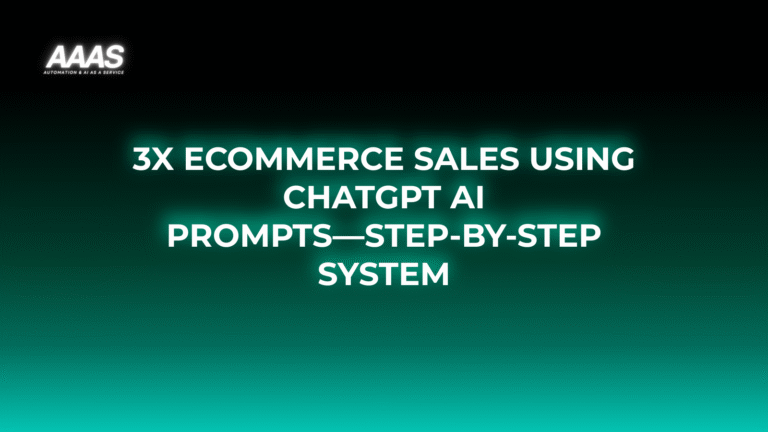Boost Online Store Conversions with ChatGPT Business Prompts for E-commerce Sales Optimization
Market Problem: Why Online Stores Struggle with Conversions
Despite heavy investments in web design, marketing, and SEO, many online stores face stubbornly low conversion rates. Common obstacles include:
- Inefficient customer support leading to abandoned carts.
- Slow response times to queries on product detail pages.
- Generic, non-personalized shopping experiences.
- Poor product recommendation accuracy.

Statistically, the average e-commerce conversion rate in 2024 hovers around 2-3% (Shopify). This leaves significant revenue untapped for most stores.
Solution: AI-Powered ChatGPT Prompts & Benefits
Deploying ChatGPT-driven business prompts can dramatically improve sales outcomes by automating, personalizing, and optimizing customer interactions 24/7.
- Instant, accurate responses to visitor queries.
- Personalized product recommendations based on preferences and browsing behavior.
- Proactive cart recovery outreach and upsell prompts.
- Seamless multi-language support for global customers.

Key Business Benefits
- Increase in overall conversion rates (often 15-30%).
- Reduced support workload and costs.
- Enhanced customer retention and satisfaction.
- Automated data collection for further marketing optimization.
Real Use Cases in E-commerce
- Product Advisor: ChatGPT helps customers find the right product by asking clarifying questions and matching preferences.
- Cart Recovery: Triggered prompts to remind and nudge customers with personalized offers or information if they abandon their basket.
- Order Tracking & FAQ Automation: Instantly answers “Where is my order?” or policy questions without human intervention.
- Personalized Upselling: Based on cart contents or browsing behavior, suggest relevant accessories or premium versions.
Explore related strategies in our AI E-commerce Conversion Guide.
Technical Details: Integrating ChatGPT with E-commerce Platforms
Main Integration Methods
- API Integration: Direct connection to OpenAI’s API for custom implementations (OpenAI API docs).
- Apps & Plugins: Pre-built Shopify, WooCommerce, and Magento plugins (many require minimal coding).
- Third-Party SaaS solutions: Chatbot builders like ManyChat, Tidio, or Chatfuel offer easy OpenAI/GPT connectors.

Prompt Engineering Essentials
- Design prompts to align with your customer journey (greeting, product help, order issues, payment support).
- Include fallback prompts to escalate to human agents if required.
- Test and optimize dialogue flows based on analytics.
Comparison with Alternative Solutions
| Method | Personalization | Scalability | Integration Ease | Cost |
|---|---|---|---|---|
| ChatGPT AI Prompts | Advanced | High | Medium | $$ |
| Rule-based Chatbots | Low | Medium | Easy | $ |
| Human Live Chat | High | Limited | Medium | $$$ |
| Static FAQ Pages | None | High | Easy | Free |
Pricing Comparison for ChatGPT AI Solutions
| Solution | Starting Price (USD/mo) | Free Tier? | Main Features |
|---|---|---|---|
| OpenAI API (GPT-4o) | $20* | No | Customizable, advanced language, API integration |
| Tidio AI Chatbot | $39 | Yes (basic) | No-code setup, GPT-powered |
| Shopify AI Apps | $10+ | Varies | Native e-commerce tools |
*API usage is pay-as-you-go; costs depend on volume. Always check OpenAI’s pricing for updates.
ROI-Focused Practical Examples
Example 1: Cart Recovery Automation
- Store A implemented ChatGPT prompts for abandoned carts.
- Result: Cart recovery rate increased from 9% to 18% — direct uplift in monthly sales revenue.
Example 2: AI Product Advisor
- Store B used GPT prompts to recommend sizes and styles in real-time.
- Result: Reduced return rates and increased average order value by 12%.
For deeper insights, read our AI Shop Chatbot Case Study.
Step-by-Step Setup Tutorial
- Define Goals. Identify conversion challenges to solve (cart abandonment, product discovery, etc.).
- Choose Platform. Decide on API, plugin, or SaaS chatbot integration.
- Register for OpenAI API. Set up an OpenAI account.
- Create API Keys and configure access on your e-commerce backend or chatbot builder.
- Design Prompts. Tailor linguistic outputs:
- Examples: “How may I help you find the right product today?” or “Would you like to know about discounts?”
- Test & Deploy. Pilot on a subset of traffic, gather feedback, and optimize prompt logic and fallbacks.
- Monitor & Analyze. Use analytics to refine dialogue, measure conversion uplifts, and automate further.

Pros and Cons
| Pros | Cons |
|---|---|
|
|
Expert Tips for Sales Optimization
- Continuously update and test prompts with real customer data to enhance accuracy and empathy.
- Integrate chat widgets across all funnel stages—homepage, product, checkout.
- Use analytics dashboards to track prompt performance and optimize flows for high-converting paths.
- Apply multilingual support to reach international customers.
- Always provide an easy path to reach a human agent for complex or sensitive inquiries.
Frequently Asked Questions
- Can ChatGPT handle PCI or sensitive payment information?
- No, ChatGPT should not process or store payment information. Use secure payment gateways and limit what your AI prompts cover.
- What platforms does ChatGPT integrate with?
- Popular integrations include Shopify, WooCommerce, Magento, Wix, and custom backends via API.
- How long does it take to set up a ChatGPT-powered chatbot?
- For apps/plugins, under 1 hour. For full API custom integrations, anywhere from a day to a week depending on requirements.
References & Citations
- Shopify: What’s a Good Conversion Rate?
- OpenAI API Documentation
- OpenAI Pricing
- Tidio: Shopify & ChatGPT Integration
Last updated: 2025-05-28


